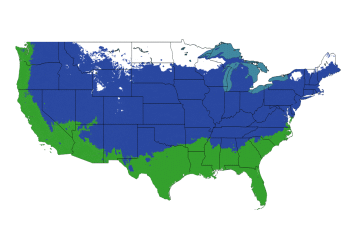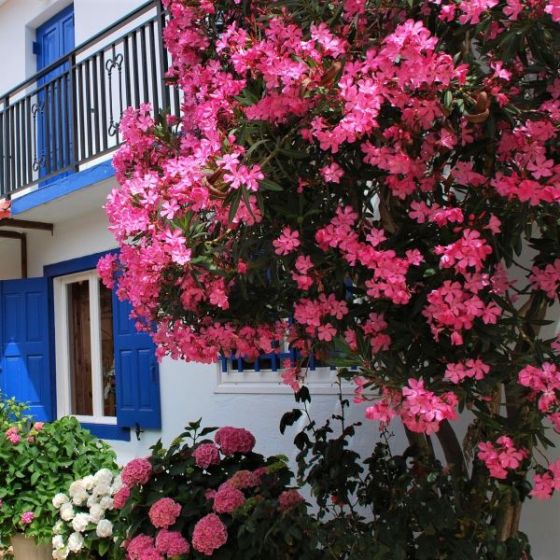✖
Oleander
Nerium oleander
As low as
$67.90
In stock
SKU
PFY-100193
Tough as Nails, Pretty Oleander Has A Long History
- Fabulous Summer Flowers
- Rich Evergreen Foliage
- "Plant It and Forget It" Tough
- Drought Tolerant
- Great in Containers
- Historical Plant Used Throughout Asia, Africa and the Mediterranean
- Screening or Specimen in Large Landscapes
- Works on the Coast
- Not Recommended for Use Near Stock Animals
- Teach Children to Leave Oleander Alone
Oleander (Nerium oleander) is a plant with a past. People love the beautiful Oleander flowers, and they have graced gardens in Asia, Africa and the Mediterranean since ancient times. They were grown in the famed gardens of Pompeii. No wonder it was brought to cultivate in the Galveston, Texas area in 1841.
These rugged garden plants caught national interest, and they found their way from Texas across the entire country. Oleander thrives in Zones 8 - 10 from Southern California with its dry heat, to both coasts, to the high heat and humidity of Florida and the Gulf Coast.
These large, pink flowering shrubs feature long, narrow lance shape leaves that capture the slightest breeze. The dazzling flowers persist from early summer to early fall.
They are well known for their ability to tolerate the harshest conditions, including drought, salt spray, reflected light from windows and painted walls, high heat and high humidity. It grows in either acid or alkaline soils.
Oleanders have been used by city planners as freeway plantings for many decades. In some areas you can drive for miles experiencing a kaleidoscope of color in the median strip. Why not line your long driveway with these time-tested shrubs?
Use Oleander wisely in your landscape. They make a wonderful hedge, a great screen plant as well as a very beautiful accent tree. They can be trained as a multi or single trunk tree and make a great featured plant in the landscape.
These are perfect accent plants in even the most aggressively warm climates. They are quick growers to their full height and are perfect for fences, borders and property edges. Oleanders are evergreen shrubs that don't need to be pruned or fussed over. You can truly plant and forget them, once they are established.
They are evergreens, so the waxy, deep-green leaf color is on the plant year-round. They put on a flower show all summer long with gorgeous trumpet-shaped blooms. They are big enough to provide a sparkling background for other flowering shrubs in the border, too.
In higher humidity, the mildly sweet Apricot fragrance of the Oleander adds another landscape attribute. This pink flowering variety features single flowers which fall cleanly from the shrub.
LetsPlantify.com ships strong field-grown plants that will arrive at your doorstep in fabulous condition, ready to plant in your garden. Order these truly 'tough as nails' but beautiful Oleanders today!
How to Use Oleander in the Landscape
You can enjoy these incredibly rugged and drought resistant plants so many ways in your landscape. With their lovely leaves and bright pink flowers, they are truly standouts in any garden.
Up close, the leaves and flowers look dainty, but from a distance, the shrub shows off a rougher texture. These plants make the perfect large backdrop for garden borders.
Create living walls for special garden rooms or hide the more mundane utility areas of your garden.
Use them as a beautiful flowering windbreak at beach properties. Plant them in a staggered double row in a zig-zagging pattern.
Train one into a small accent tree by removing lower limbs. It can create a marvelous focal point in a drought tolerant, xeriscape garden.
Mass them on tough, sunny sites, such as slopes. It's far easier and safer to allow them to grow into their full height and spread than trying to mow.
Line the perimeter of a large commercial or home property with a great looking Oleander hedge. For a long, continuous hedge, plant Oleander 5 feet apart (you'll measure from the center of one to the center of the next.)
Oleander also makes a wonderful container plant and patio accent plant. Although it is not cold hardy, people in colder climates can grow them as summer flowering container plants. In Zones 4 - 7, simply move them to an attached garage with a window in winter to protect from the cold. Remember to water your containerized Oleander in winter!
#ProPlantTips for Care
In the home garden, care must be taken to avoid the highly toxic sap. While kids tend to steer clear of anything "green" like vegetables or Oleander, it's best to educate them early to leave this plant alone. Even though the leaves are extremely bitter and unpalatable, it is not a shrub recommended for use near stock animals. Some people also have a sensitivity to leathery Oleander leaves. Wear gloves to avoid skin irritation while handling.
Oleander stays fresh and flowers with little assistance. However, you can prune it to encourage bushier growth and more flowers, and to reduce the size of the shrub.
It blooms on new wood. It's best to prune them after the summer blooms are finished.
Regularly remove damaged, criss-crossing or dead branches to keep your plants healthy. Be sure to bag and remove pruned branches from the site. The limbs and leaves should not be use as firewood or the limbs to cook with.
Once your plants are 10 years old, start a regular maintenance program of rejuvenation pruning. in spring, cut 1/3 of the oldest trunks off at the ground level in spring and remove from your property. In a three-year period, you'll have a brand new shrub without losing valuable height.
Oleander is as drought tolerant as a landscape shrub or tree can be. Water regularly for the first year and less the next year and needs very little supplemental water from then on.
The plant is adapted to almost all soils and can even tolerate brief periods of flooding. However, overwatering can lead to yellowing leaves. Best to keep this arid native on the dry side with well-drained soil. When supplemental water is given, water the soil at the roots and keep the leaves dry.
Apply a 2-inch layer of compost under the plant each spring to retain moisture and control weeds.
In containers, Oleanders require regular watering and must be fed a general-purpose fertilizer at least twice a season. Recommended application rate is once in the late winter and once on the late summer.
You'll love these plants that provide a burst of color in your yard. They'll grow beautifully, even in poor soil and extreme heat. Don't miss your chance - order today!
| Botanical Name | Nerium oleander |
|---|---|
| Mature Height | 6 - 15 feet |
| Mature Spread | 5 -10 feet |
| Soil Type | Widely Adaptable |
| Moisture | Low |
| Sun Exposure | Full Sun |
| Growth Rate | Medium |
| Bloom Period | Summer |
| Flower Color | Pink |
| Foliage Color | Green |
| Pollinator Required | No |
| Pollinator Friendly | No |
| Growing Zone Range | 8-11 (Patio 4-11) |

Write Your Own Review

